The last IJN Biplane
Genesis for this model started in 1935 when first planned to succeed the Nakajima E8N as main catapult-launched navy spotter, mostly based on cruisers (The E13N was for battleships and succeed the E7K). The E8N (assigned the identifier “Dave” by US Intel) was a sturdy, reliable model, but slow and underpowered. Coming from the 1932 7-Shi specification, later 8-shi in 1933 it first flew in 1934 and was deployed from late 1935 and early 1936 too all capital ships and 16 cruisers of the IJN, plus five seaplane tenders.
As customary as soon it was introduced a new specification planned its successor, was made known to three manufacturers in 1934, Mitsubishi, Aichi and Kawanishi.
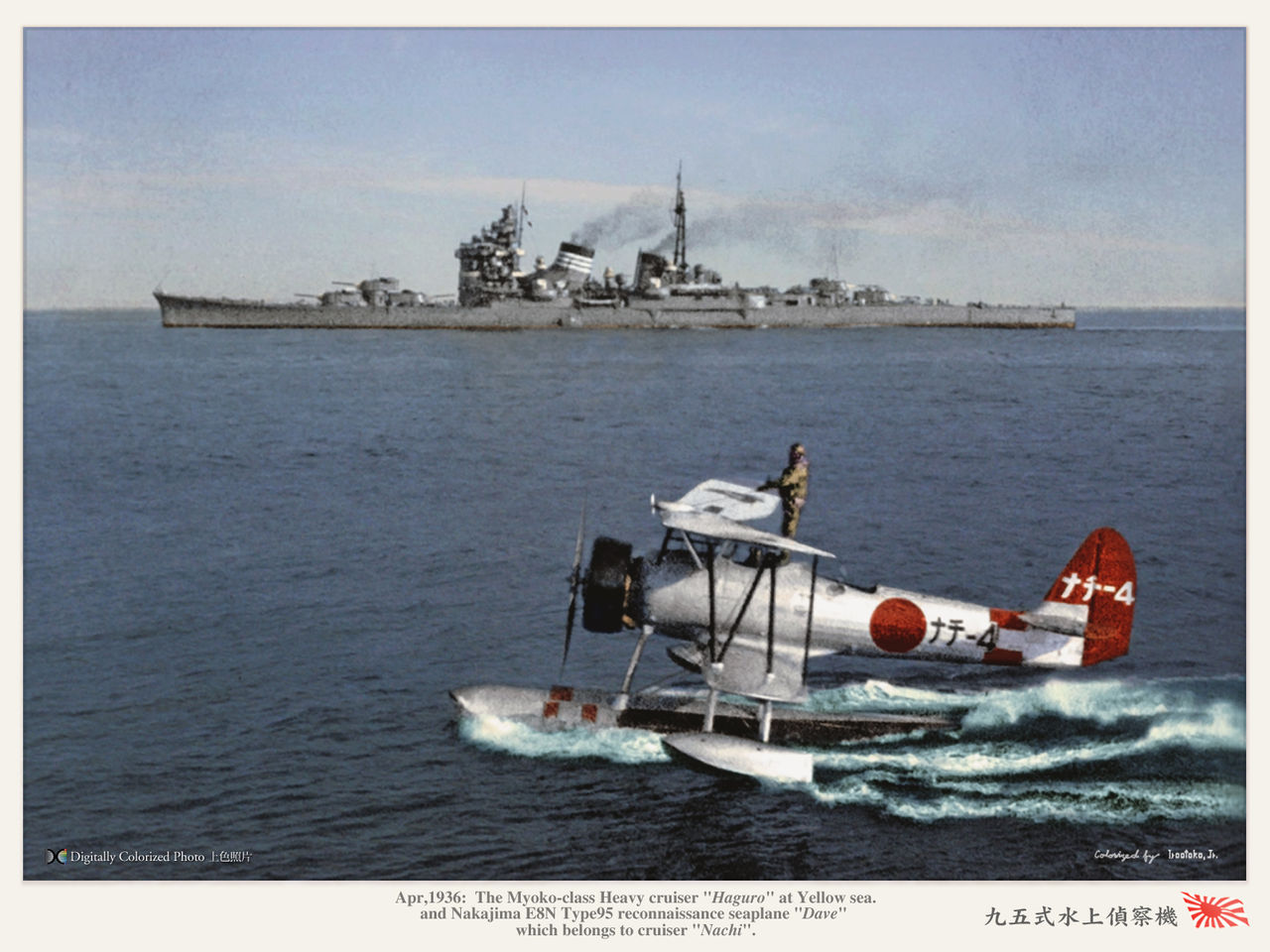
F1M predecessor, the E8N
Design development (1936-40)
In 1934, the specs called for still a short-ranged reconnaissance and observation model to be catapult-launched, and only with improved performances, now allowed by more powerful engines. Mitsubishi’s answered with the Ka-17, which was tested in 1935 and first flew in June 1936 after revisions of the specifications. It was proved superior to its competitors from Aichi and Kawanishi and thus, earned the contract. The F1M1 performed better than the Aichi but was plagued by poor stability while swimming and flying.
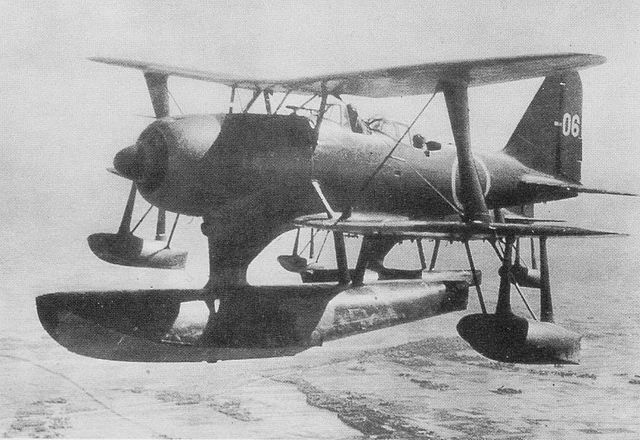
It was thus redesigned to solve these issues, and notably the wings were redesigned this time with a straight tapered leading edge, as well as trailing edges, plus they were rigged with a greater dihedral. Also to really nail stability, the vertical fin and rudder were much enlarged. Its floats were also enlarged to increase buoyancy and stability when at sea. Also, the Mitsubishi Hikari engine was replaced by a 652 kilowatts (875 hp) Mitsubishi Zuisei 14-cyl. radial engine, with a redesigned cowling which gave it better forward visibility. The final fuselage was smooth and aerodunamic.
Tested again later in 1936, the pilot resported its handling characteristics were greatly improved. The Navy appreciated the effort made by Mitsbushi and greenlighter production, as the “Navy Type 0 observation seaplane Model 11”, with the short designation F1M2. The F1M1 was only produced to four prototypes. 940 aircraft were built in total, 342 by Mitsubishi and 598 by Sasebo Arsenal, plus the 21st Arsenal. Production started in early 1941, after Mitsubishi had to create an entirely new production chain for it, already busy with other models such as the A5M.
Design
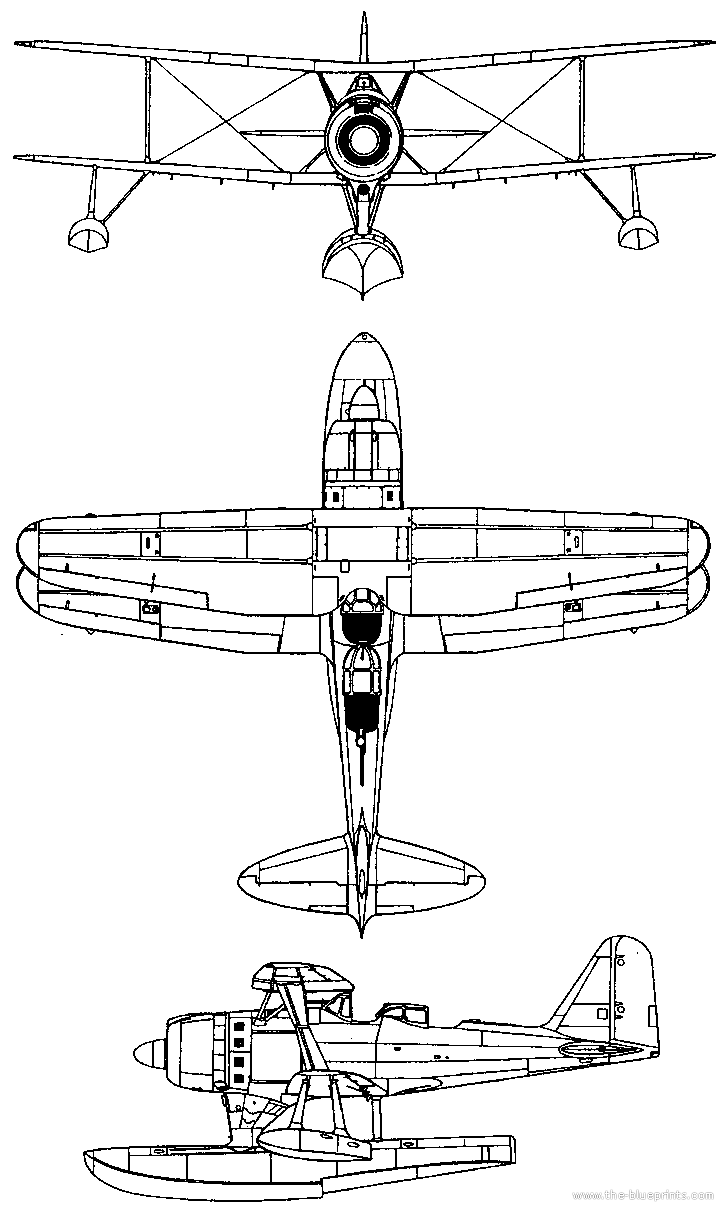
The Ka-17 was a small all-metal biplane, powered by a single Nakajima Hikari 1 radial engine. The latter was rated for 610 kilowatts (820 hp) and basically was the same which propelled its direct competitor, the Aichi F1A. This was still a biplane, but with elliptical wings and many wind tunnels studies and design care to reduce drag. Bracing was reduced to the minimum and interplane struts much simplified: It had “n” struts between the central upper wing and fuselage, and simple pillar-like profiled struts to maintained both upper and low wings.
Also the large central float was attached to the belly by a single, profiled large pillar, followed by a rear “V” strut attachment. Both fmaller underwings floats were attached by “N” type struts. Bracing was only provided in a “X” tranverse fashion between the wings. Thanks to its Mitsubishi MK2C Zuisei 13, 14-cylinder air-cooled radial piston engine rated for 652 kW (875 hp) (ar take-off), or 600 kW (800 hp) at 3,500 m at 11,500 ft mated to a 3-bladed variable-pitch metal propeller, the The F1M2 had a maximum speed of 368 km/h (230 mph). Its max range was up to 1,072 km (670 mi) light (no payload). it was also armed with three 7.7 mm (.303 in) machine guns: Two fixed forward-firing on the nose, and a single flexible mounted rear-firing one for the observer. The underwings had racks for two 60 kg (132 lb) bombs. So this made for a versatile platform.
A single variant was manufactured, the F1M2-K two-seat training version.
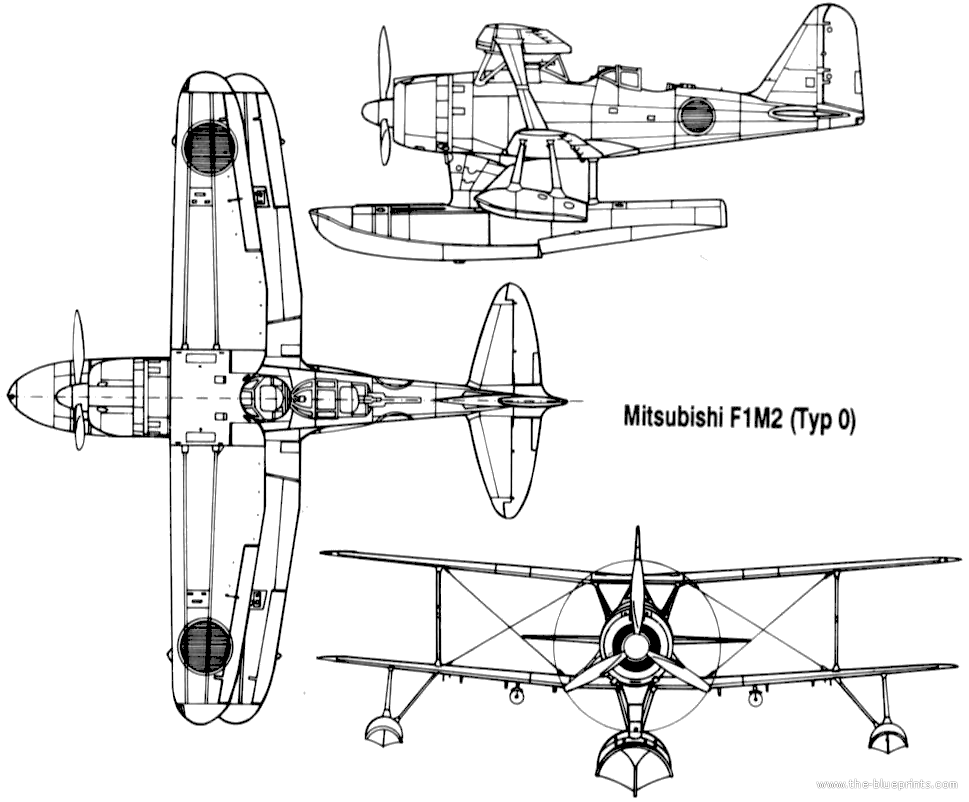
Detailed specs
Mitsubishi F1M2 |
|
| Crew: | 2: Pilot, radio/observer/gunner |
| Fuselage Lenght | 9.5 m (31 ft 2 in) |
| Wingspan | 11 m (36 ft 1 in) |
| Wing area | 29.5 m2 (318 sq ft) |
| Height | 4 m (13 ft 1 in) |
| Empty weight: | 1,928 kg (4,251 lb) |
| Max takeoff weight: | 2,856 kg (5,622 lb) |
| Propeller: | 3-bladed metal propeller |
| Engine: | Mitsubishi MK2C Zuisei 13 14-cyl. 652 kW (875 hp) TO/600 kW (800 hp) at 3,500 m |
| Top speed: | 370 km/h (230 mph, 200 kn) at 3,440 m (11,290 ft) |
| Climb rate: | 5,000 m (16,000 ft) in 9 min 36 sec |
| Range: | 740 km (460 mi, 400 nmi) |
| Service ceiling: | 9,440 m (30,970 ft) |
| Wing Loading: | 86.3 kg/m2 (17.7 lb/sq ft) |
| Power/mass: | 0.156 hp/lb (0.256 kW/kg) |
| Armament: MGs | 2 × fixed fwd 7.7 mm (.303 in) Type 97, 1× flexible rear Type 92 LMG |
| Armament: Bombs | 2× 60 kg (132 lb) bombs (or single 250 kg bomb for suicidal missions) |
The F1M2 in action

Introduced a bit late as a biplane (almost six years after its first flight !) this model was the last biplane in service with the IJN. The formula had its advantages through: Although it limited top speed and high-G evolutions, the structure proved sturdy enough to practice dive bombing if needed. The reduced span and high lift was also an advantage for onboard storage, handling and lift when catapultes. The engine proved powerful enough to give extra agility to this model, and surprisingly enough, the “Pete” was used as fighter when the occasion arose, against allied bombers mostly.
The F1M was deployed in the fleet for gunnery spotting alongside the Nakajima E13A. In 1940 the Type 0 Model 11 was aboard eight battleships, including the Nagato and Yamato, nine cruisers and six aircraft tenders, plus many shore based units. Although the F1M’s comparatively low speed made it vulnerable to the best Allied fighters, it could successfully be used as a front line aircraft in secondary theatres (of which there were many in the Pacific).
The F1M even sometimes acted as a fighter in these isolated islands, or was seen acting as dive bomber in support of amphibious landings early on in 1942, and also a convoy escort aircraft, although limited somewhat by its short range, making ASW coastal patrols. Its main strength here was its manoeuvrability, so it was not eve, considered a threat by second-line Allied aircraft, which underestimated its capabilities.
The “Pete” performed soon a large veriety of mission when deployed over China: Convoy escort, bomber, anti-submarine and maritime patrol, but also rescue, transport, and anti-shipping strike: In one occasion, a “pete” equipped with bombs made a hit and sank the Motor Torpedo Boat PT-34, on 9 April 1942. Later in the war, it was also used as area-defense fighter, seeing impromptu fights with US planes in the Aleutians, notably the F4F Wildcat.
The F1M also saw plenty of action in and around the Solomons and played its part in all subsequent engagements, notably in New Guinea, used as point-defense fighter against Australian and US bombers and fighters coming from nearby Australia. The F1M was also the last IJN observation model to see large production and widespread use. Although its replacement was planned, as the Kawanishi E15K Shiun “Norm”, it never arrived in service in time (only 15 were delivered). In 1945, Indonesians captured a few F1M2s, which were used to fight the Dutch all along the gruelling Indonesian National Revolution. The Royal Thai Navy also operated some in 1944.
References
Francillon, R.J. Japanese Aircraft of the Pacific War. Putnam, 1970.
Green, William. War Planes of the Second World War, Volume Six: Floatplanes. Macdonald & Co.
Wieliczko, Leszek A. (2017). “Mitsubishi F1M (Pete)”. Technika Wojskowa Historia
aviastar.org
militaryfactory.com
On pacificeagles.net
On historyofwar.org
On daveswarbirds.com
Footage
Footage
Mitsubishi_F1M
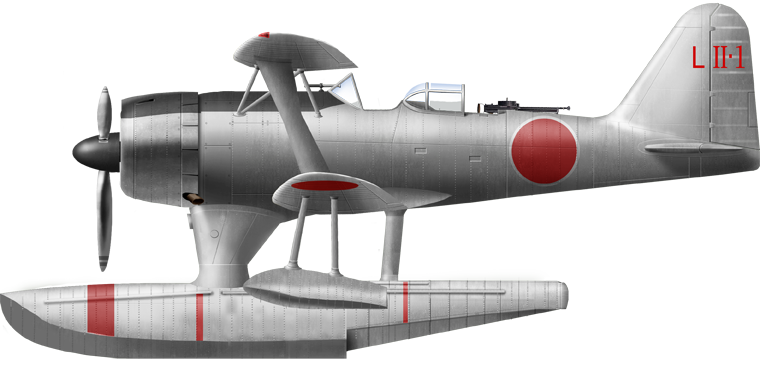
F1M1 in grey livery, 1941
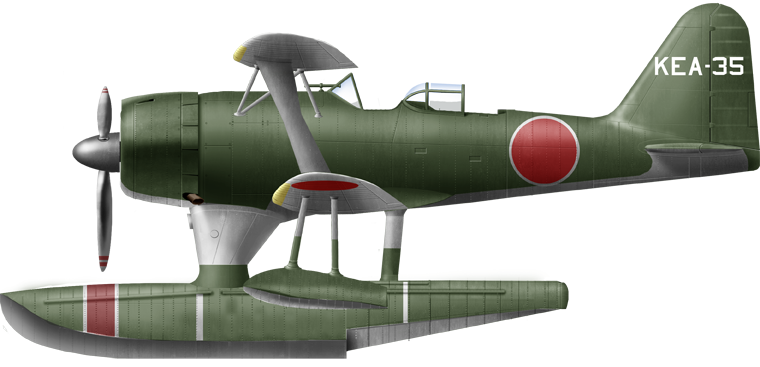
F1M1 in green livery, 1942
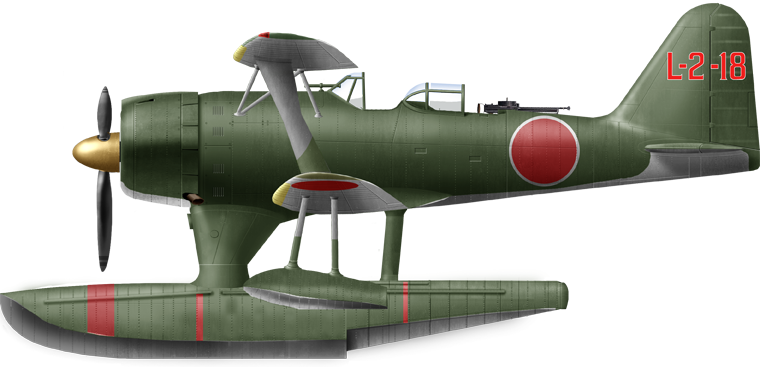
F1M2, unknown unit
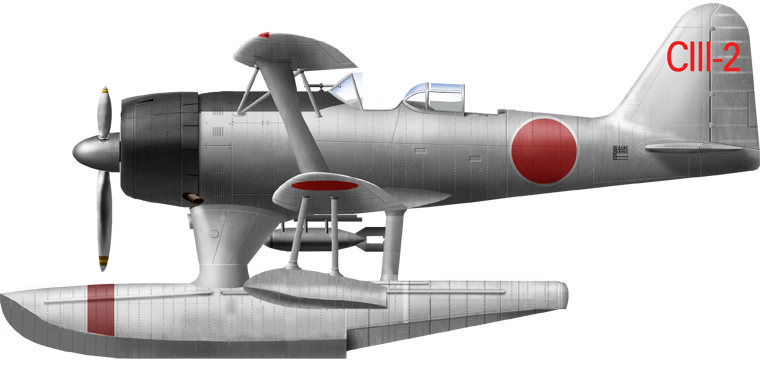
F1M2 IJN Haruna, Bat. Guadalcanal, November 1942
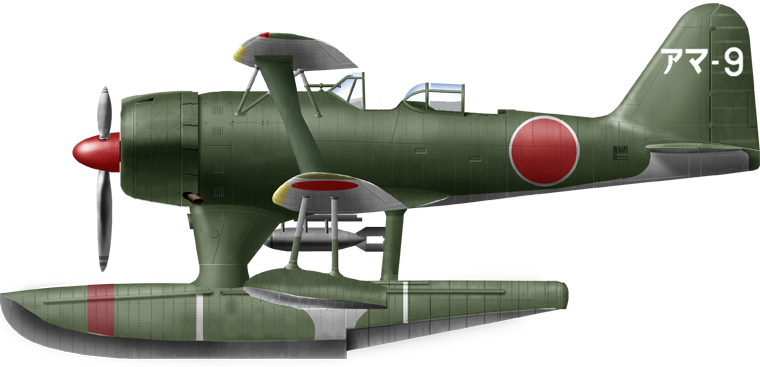
F1M2 in June 1945, used by a Kamikaze unit.
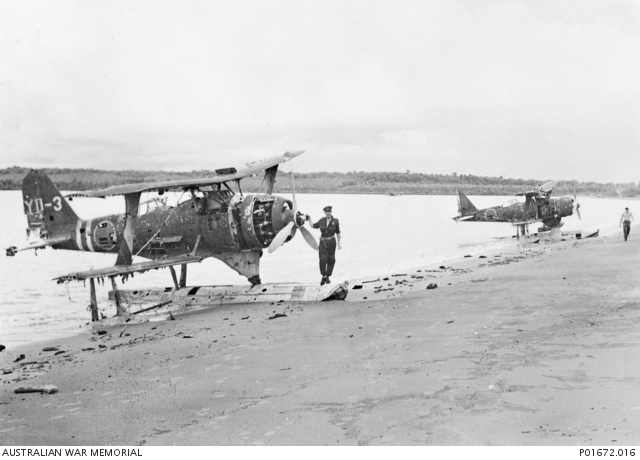
Two damaged Mitsubishi F1M2 (Allied code name “Pete”) observation seaplanes beached at the former Japanese seaplane base at Rekata Bay on the northern end of Santa Isabel island in March 1944. The man standing on the float of the nearer aircraft is flight lieutenant J. Beattie, Royal New Zealand Air Force.
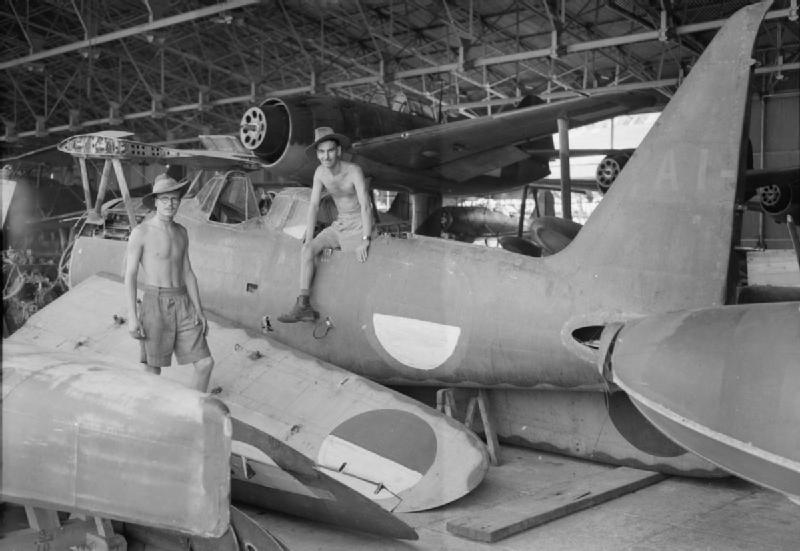
Captured parts of an Indonesian “Pete”: Corporal Ralph Hayden and Leading Aircraftman Harry Pearce of No. 80 Squadron RAF amongst parts of a Mitsubishi F1M, bearing Indonesian markings, at an airfield and seaplane base in Surabaya (Soerabaja), Java, January 1946. In the background are Kawanishi N1K floatplanes.
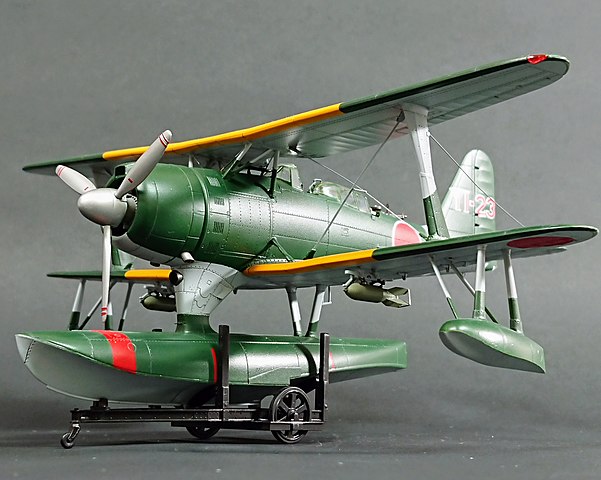
Model kit
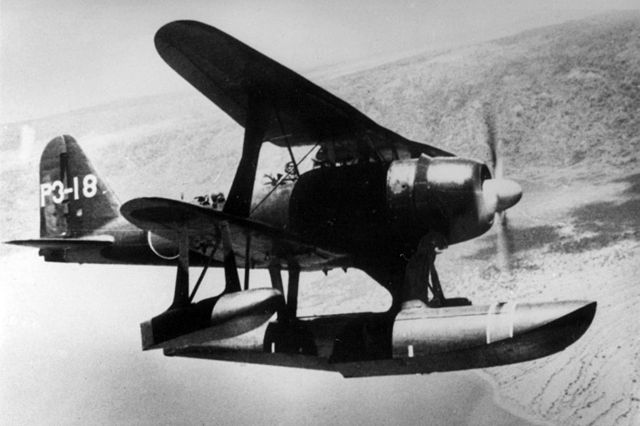
F1M1 over Rabaul
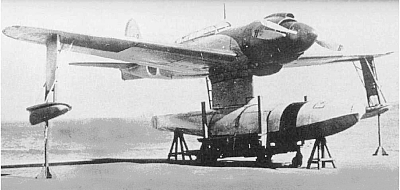
Planned replacement: The Kawanishi E15K Shiun (1942)

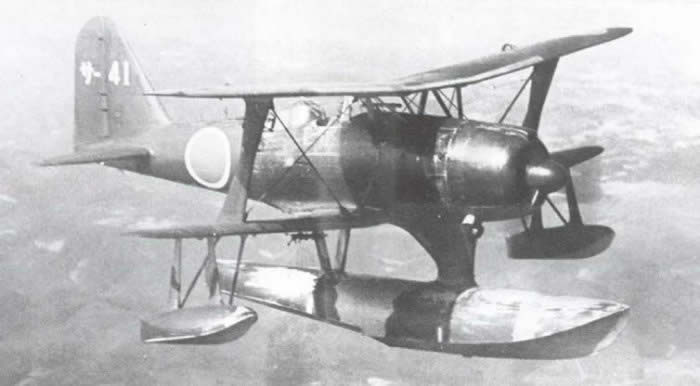
 Latest Facebook Entry -
Latest Facebook Entry -  X(Tweeter) Naval Encyclopedia's deck archive
X(Tweeter) Naval Encyclopedia's deck archive Instagram (@navalencyc)
Instagram (@navalencyc)





 French Navy
French Navy Royal Navy
Royal Navy Russian Navy
Russian Navy Armada Espanola
Armada Espanola Austrian Navy
Austrian Navy K.u.K. Kriegsmarine
K.u.K. Kriegsmarine Dansk Marine
Dansk Marine Nautiko Hellenon
Nautiko Hellenon Koninklije Marine 1870
Koninklije Marine 1870 Marinha do Brasil
Marinha do Brasil Osmanlı Donanması
Osmanlı Donanması Marina Do Peru
Marina Do Peru Marinha do Portugal
Marinha do Portugal Regia Marina 1870
Regia Marina 1870 Nihhon Kaigun 1870
Nihhon Kaigun 1870 Preußische Marine 1870
Preußische Marine 1870 Russkiy Flot 1870
Russkiy Flot 1870 Svenska marinen
Svenska marinen Søværnet
Søværnet Union Navy
Union Navy Confederate Navy
Confederate Navy Armada de Argentina
Armada de Argentina Imperial Chinese Navy
Imperial Chinese Navy Marinha do Portugal
Marinha do Portugal Mexico
Mexico Kaiserliche Marine
Kaiserliche Marine 1898 US Navy
1898 US Navy Sovietskiy Flot
Sovietskiy Flot Royal Canadian Navy
Royal Canadian Navy Royal Australian Navy
Royal Australian Navy RNZN Fleet
RNZN Fleet Chinese Navy 1937
Chinese Navy 1937 Kriegsmarine
Kriegsmarine Chilean Navy
Chilean Navy Danish Navy
Danish Navy Finnish Navy
Finnish Navy Hellenic Navy
Hellenic Navy Polish Navy
Polish Navy Romanian Navy
Romanian Navy Turkish Navy
Turkish Navy Royal Yugoslav Navy
Royal Yugoslav Navy Royal Thai Navy
Royal Thai Navy Minor Navies
Minor Navies Albania
Albania Austria
Austria Belgium
Belgium Columbia
Columbia Costa Rica
Costa Rica Cuba
Cuba Czechoslovakia
Czechoslovakia Dominican Republic
Dominican Republic Haiti
Haiti Hungary
Hungary Honduras
Honduras Estonia
Estonia Iceland
Iceland Eire
Eire Equador
Equador Iran
Iran Iraq
Iraq Latvia
Latvia Liberia
Liberia Lithuania
Lithuania Mandchukuo
Mandchukuo Morocco
Morocco Nicaragua
Nicaragua Persia
Persia San Salvador
San Salvador Sarawak
Sarawak Uruguay
Uruguay Venezuela
Venezuela Zanzibar
Zanzibar Warsaw Pact Navies
Warsaw Pact Navies Bulgaria
Bulgaria Hungary
Hungary

 Bundesmarine
Bundesmarine Dutch Navy
Dutch Navy Hellenic Navy
Hellenic Navy Marina Militare
Marina Militare Yugoslav Navy
Yugoslav Navy Chinese Navy
Chinese Navy Indian Navy
Indian Navy Indonesian Navy
Indonesian Navy JMSDF
JMSDF North Korean Navy
North Korean Navy Pakistani Navy
Pakistani Navy Philippines Navy
Philippines Navy ROKN
ROKN Rep. of Singapore Navy
Rep. of Singapore Navy Taiwanese Navy
Taiwanese Navy IDF Navy
IDF Navy Saudi Navy
Saudi Navy Royal New Zealand Navy
Royal New Zealand Navy Egyptian Navy
Egyptian Navy South African Navy
South African Navy






























 Ukrainian Navy
Ukrainian Navy dbodesign
dbodesign